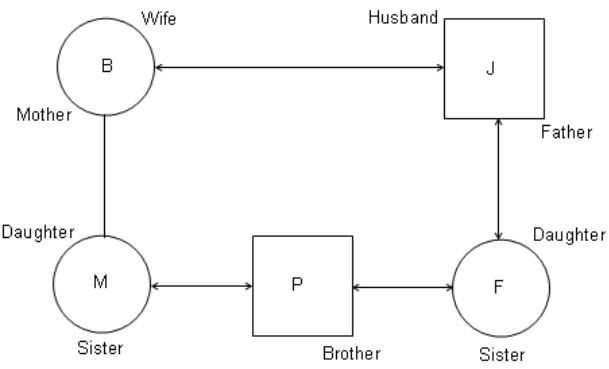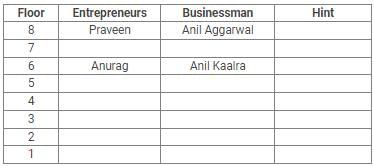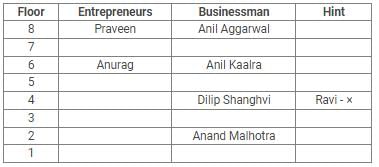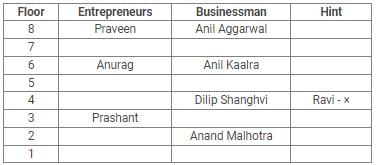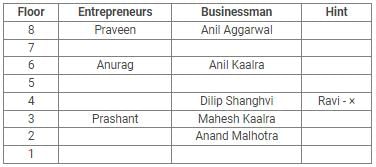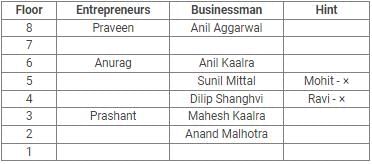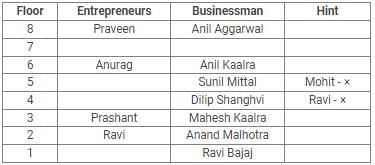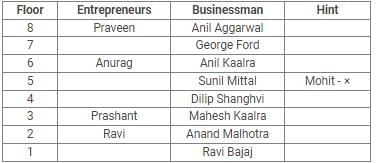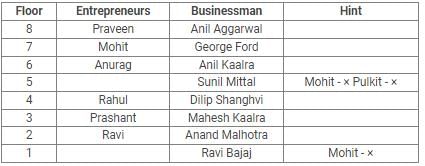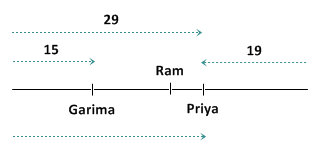EPFO Assistant Mains Mock Test - 9 - Bank Exams MCQ
30 Questions MCQ Test - EPFO Assistant Mains Mock Test - 9
Instructions (Q1 to Q10): In each of the following questions two statements are given and these statements are followed by two conclusions numbered (1) and (2). You have to take the given two statements to be true even if they seem to be at variance from commonly known facts. Read the conclusions and then decide which of the given conclusions logically follows from the two given statements, disregarding commonly known facts.
Statements:
Some actors are singers.
All the singers are dancers.
Conclusions:
1. Some actors are dancers.
2. No singer is actor.
Some actors are singers.
All the singers are dancers.
1. Some actors are dancers.
2. No singer is actor.
Direction: Study the following information and answer the questions that follow:
Five guest lecturers have to be scheduled for students starting from Monday and ending on Friday of the same week. The topics of lectures are maths, science, language, civics, and grooming, not necessarily in the same order. The experts for lectures belong to Hyderabad, Chennai, Mumbai, Delhi, and Jaipur, not necessarily in the same order. Three guest lecturers are females and two are males.
The males will take lectures on alternate days and won't be available on Monday. The expert who belongs to Delhi is a female and is free only on Tuesday. The Civics lecture needs to be scheduled on Wednesday. Neither grooming nor maths can be scheduled for Monday. The language lecture should be scheduled after civics. The grooming expert belongs to Hyderabad. The expert of science neither belongs to Chennai, nor to Jaipur. A female expert belongs to Jaipur.
Q.
The Civics lecture was delivered by an expert from which of the following day?
The Civics lecture was delivered by an expert from which of the following day?
Directions: Read the following statements carefully and answer the given question.
I. J is the father of F, but F is not the son of J.
II. M is the daughter of B and sister of P.
III. P is the brother of F.
Q. Which of the following statements is/are true?
II. M is the daughter of B and sister of P.
III. P is the brother of F.
Directions: Study the following information carefully and answer the given question.
When a word and number arrangement machine is given an input line of words and numbers, it arranges them following a particular rule. The following is an illustration of input and rearrangement.
Input: engineer 30 marble famous 41 52 seven 61 rough 36 89 jump
Step 1: engineer famous 30 marble 41 52 seven 61 rough 36 89 jump
Step 2: engineer famous 89 61 30 marble 41 52 seven rough 36 jump
Step 3: engineer famous 89 61 jump marble 30 41 52 seven rough 36
Step 4: engineer famous 89 61 jump marble 52 41 30 seven rough 36
Step 5: engineer famous 89 61 jump marble 52 41 rough seven 30 36
Step 6: engineer famous 89 61 jump marble 52 41 rough seven 36 30
Step 6 is the last step of the above input.
Now, as per the rules followed in the above steps, answer the given question based on the following input:
Input: bone 11 alluring 25 major 47 81 enough 49 simple 16 anxious
Q. Which of the following terms exactly comes between '49' and 'enough' in Step 3?
Directions: Read the given information carefully and answer the questions given beside:
Eight persons are living in an apartment having eight floors. First floor is numbered one; second floor is numbered two and so on till the top-most floor which is numbered eight. There are eight entrepreneurs and eight leading businessmen in the building. On each floor one entrepreneur lives with one leading businessman. The names of the eight entrepreneurs are – Mohit, Ravi, Pulkit, Praveen, Anurag, Nishant, Prashant and Rahul – not necessarily in the same order. The names of the eight businessmen are – Mahesh Kaalra, Sunil Mittal, Anil Aggarwal, Ravi Bajaj, Anand Malhotra, George Ford, Dilip Shanghvi and Anil Kaalra.
Rahul is staying on an even – numbered floor and Ravi Bajaj is staying on the first floor. There are two persons staying between the floors on which Prashant and Anurag live. Praveen is staying on the topmost floor with Anil Aggarwal. Sunil Mittal is staying on the floor exactly below the floor of Anil Kaalra but not with Pulkit. Mahesh Kaalra is staying exactly between the floors of Dilip Shanghvi and Anand Malhotra but not on the fifth floor. Prashant is staying on the third floor. Ravi is staying on an even – numbered floor and Mohit is staying on an odd – numbered floor but not on the first floor. Dilip Shanghvi is staying on the fourth floor but Ravi is not staying with him. Anand Malhotra is staying on the second floor. George Ford and Mohit are not staying on the fifth floor. Anil Kaalra is staying with Anurag on floor number sixth.
Q. Ravi is staying on which floor?
In a row where all are facing north, Priya is 15th from the left end and Garima is 19th from the right end. They interchange their positions, and Ram who sits 24th from the left end sits at the 5th place to the left of Priya's new position. How many persons were there in the row?
P can complete a work in 12 days working 8 hours a day. Q can complete the same work in 8 days working 10 hours a day. If both P and Q work together, working 8 hours a day, in how many days can they complete the work?
Walking 6/7th of his usual speed, a man is 12 minutes too late. What is the usual time taken by him to cover that distance?
John and Dani go for an interview for two vacancies. The probability for the selection of John is 1/3 and whereas the probability for the selection of Dani is 1/5. What is the probability that none of them are selected?
John and Dani go for an interview for two vacancies. The probability for the selection of John is 1/3 and whereas the probability for the selection of Dani is 1/5. What is the probability that only one of them is selected?
60 litres of a 75% solution of wine is taken into a laboratory. 4 litres of the solution is flushed and 4 litres of water is added to compensate the loss. Then 5 litres of the solution is flushed again and 5 litres of water is added. Again 6 litres of the solution is flushed and 6 litres of water is added. The final concentration of wine in the solution is
The prices of two articles are in the ratio 3 : 4. If the price of the first article be increased by 10% and that of the second by Rs. 4, the original ratio remains the same. The original price of the second article is
After giving a discount of 40%, the profit becomes half (in amount) with respect to the total profit when there is no discount. What percent discount has to be given if there is no profit and no loss?
Do the roses in your garden smell / more sweetly / than those in ours? / No error
Fill in the blank (1) from suitable given options:
The ….(1)….. citizen who has to get everyday jobs done by various municipal and government departments is ………..(2)... driven up a tree, first…(3).. them, second explaining to them what is ….. (4)….. and lastly, getting the job done.
If this week I …. (5)…..some personal experience in this column, it is because I can document them. It is not to ask for any special…(6)….. or voice personal…(7)..but to bring into public view the experience of hundreds, if not thousands of citizens everyday of the year and express the collective….(8)… of all of them. Because one’s usual experience is that when such complaints are….(9)…… in such columns, the departments rush to ….(10)……
Directions: The following question has two blanks. In each blank a preposition has been omitted. Choose the set of prepositions for each blank that best fits in the context of the sentence.
India has strengthened its cellular internet connectivity in the recent years, and it is a milestone in its _______________ rise in the global stage.
I. meteoric
II. stagnating
III. monetary
Direction: The sentences given in the question, when properly sequenced, form a coherent paragraph. Each sentence is labeled with a letter. Choose the most logical order of sentences from the given choices to construct a coherent paragraph.
A. Not long after their victory, the Greeks began to think that they would never stack up to the glories of the past.
B. Throughout antiquity, those warriors, especially the Marathonomachai, who fought and defeated the Persian troops in the 490 BCE Battle of Marathon, would be revered as Athens’ Greatest Generation.
C. Even in the mid-fifth century BCE, Athenians were already looking back with longing.
D. A few decades earlier, Athenian citizen-soldiers had helped to rout the Persian invaders of Greece.
Direction: Read the following passage carefully and answer the question that follows.
The Supreme Court on Tuesday asked the Union government whether it is giving the over 40 lakh people, excluded from the National Register of Citizens (NRC) in Assam, a “second chance” to gain citizenship by allowing them to produce fresh documents to prove their Indian legacy.
The court was referring to the Standard Operating Procedure (SOP) proposed by the government, which allows a claimant for Indian citizenship to “change his legacy” by submitting additional documents at the ‘claims and objections’ stage. The court asked whether this would amount to “re-doing the claims” of those left out from the draft NRC published on July 30.
A Bench of Justices Ranjan Gogoi and Rohinton Nariman on Tuesday said allowing a claimant to change his legacy would amount to “tinkering with the family tree” and re-doing the verification process.
“You see, a claimant submits documents to prove his legacy from his father. A family tree is drawn, which includes the claimant’s siblings, etc. The authorities verify his claim with each one of the member in the family tree before deciding his claim [for citizenship]. Now, your SOP says that a person can submit fresh documents claiming to prove his legacy from his grandfather. Now, the family tree has to be recreated. Everything has to be re-verified. This amounts to redoing the entire exercise. Why?”, Justice Gogoi asked Attorney General K.K. Venugopal.
Besides, the Bench pointed out, the government, in the beginning, had specified that documents on legacy would be allowed to be filed only once. Now, it has changed tack to permit additional documents to be filed. “Are you not contradicting yourself here?” Justice Gogoi asked Mr. Venugopal.
The court directed Assam State NRC Coordinator Prateek Hajela to file a report on the ramifications of the government's proposal to submit fresh documents. Mr. Hajela has to file his report before September 5, the next date of hearing.
Meanwhile, the court deferred the receipt of claims and objections to a later date. This stage was supposed to start within the next days, on August 30, and would have continued till October 28.
“Allowing a person to suddenly pull out an additional document, that too at the 'claims and objections' stage, will upset the search apple cart,” Justice Nariman observed.
Mr. Venugopal countered that the government is giving “another chance to people who risk losing all their rights”.
To this, Justice Nariman agreed that the court was dealing with “human problems of a huge magnitude”.
“Consequences are so severe that should they be given one more chance. Suppose a claimant has misfired once but can deliver in the next. Why should such a person not be given another chance?” Justice Nariman asked Mr. Hajela, stakeholders and petitioners in the litigation.
To this, Mr. Hajela said reopening of family trees would risk the possibility of “trading of legacies or meeting of minds”. "Giving a second chance would only open trading in legacies. There may be people who are willing to sell the legacies to others,” he said.
The Supreme Court further asked Mr. Hajela to submit a report with a time-frame to carry out the sample re-verification of at least 10 per cent of the names included in the final draft NRC. This is after Mr. Hajela placed before the Bench a district-wise data of the percentage of the population who have been excluded from the final draft NRC.
Q. Which among the following is a possible consequence of the new standard operating procedure adopted by the Government regarding the National Register of Citizens?
Direction: Read the following passage carefully and answer the question that follows.
The Supreme Court on Tuesday asked the Union government whether it is giving the over 40 lakh people, excluded from the National Register of Citizens (NRC) in Assam, a “second chance” to gain citizenship by allowing them to produce fresh documents to prove their Indian legacy.
The court was referring to the Standard Operating Procedure (SOP) proposed by the government, which allows a claimant for Indian citizenship to “change his legacy” by submitting additional documents at the ‘claims and objections’ stage. The court asked whether this would amount to “re-doing the claims” of those left out from the draft NRC published on July 30.
A Bench of Justices Ranjan Gogoi and Rohinton Nariman on Tuesday said allowing a claimant to change his legacy would amount to “tinkering with the family tree” and re-doing the verification process.
“You see, a claimant submits documents to prove his legacy from his father. A family tree is drawn, which includes the claimant’s siblings, etc. The authorities verify his claim with each one of the member in the family tree before deciding his claim [for citizenship]. Now, your SOP says that a person can submit fresh documents claiming to prove his legacy from his grandfather. Now, the family tree has to be recreated. Everything has to be re-verified. This amounts to redoing the entire exercise. Why?”, Justice Gogoi asked Attorney General K.K. Venugopal.
Besides, the Bench pointed out, the government, in the beginning, had specified that documents on legacy would be allowed to be filed only once. Now, it has changed tack to permit additional documents to be filed. “Are you not contradicting yourself here?” Justice Gogoi asked Mr. Venugopal.
The court directed Assam State NRC Coordinator Prateek Hajela to file a report on the ramifications of the government's proposal to submit fresh documents. Mr. Hajela has to file his report before September 5, the next date of hearing.
Meanwhile, the court deferred the receipt of claims and objections to a later date. This stage was supposed to start within the next days, on August 30, and would have continued till October 28.
“Allowing a person to suddenly pull out an additional document, that too at the 'claims and objections' stage, will upset the search apple cart,” Justice Nariman observed.
Mr. Venugopal countered that the government is giving “another chance to people who risk losing all their rights”.
To this, Justice Nariman agreed that the court was dealing with “human problems of a huge magnitude”.
“Consequences are so severe that should they be given one more chance. Suppose a claimant has misfired once but can deliver in the next. Why should such a person not be given another chance?” Justice Nariman asked Mr. Hajela, stakeholders and petitioners in the litigation.
To this, Mr. Hajela said reopening of family trees would risk the possibility of “trading of legacies or meeting of minds”. "Giving a second chance would only open trading in legacies. There may be people who are willing to sell the legacies to others,” he said.
The Supreme Court further asked Mr. Hajela to submit a report with a time-frame to carry out the sample re-verification of at least 10 per cent of the names included in the final draft NRC. This is after Mr. Hajela placed before the Bench a district-wise data of the percentage of the population who have been excluded from the final draft NRC.
Q. Which among the following substantiates the observation of the Supreme Court that the government is contradicting its own stand in the issue of National Register of Citizens?
Consider the following oceanic salts:
1) Sodium Chloride
2) Magnesium Chloride
3) Magnesium Sulphate
4) Calcium Sulphate
Q. Which of the following represents the decreasing order of their presence in oceanic waters:
The Vitamin which helps in clotting of blood is :
Where is the Forest Research Institute of India located?
Who among the following was associated with the Mughal Court as a physician to Prince Dara Shikoh?
Increase in the value of domestic commodities in terms of foreign currency is known as
Financial inclusion attempts to provide digital financial solutions to the country's economically disadvantaged citizens. Which of the following is one among the schemes introduced to promote Financial Inclusion?
Which of the following Organization introduced the concept of Financial Inclusion in India ?
What are the causes of Non- Performing Assets (NPAs)?
As per the RBI instructions in case of a failed ATM transaction, the card-issuing bank has been mandated to resolve the customer complaint by re-crediting the customer's account within ______ working days from the date of complaint.
What is the purpose of Bajaj Allianz Life ACE, the newly launched life insurance plan?





